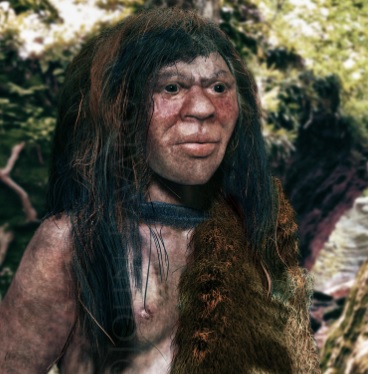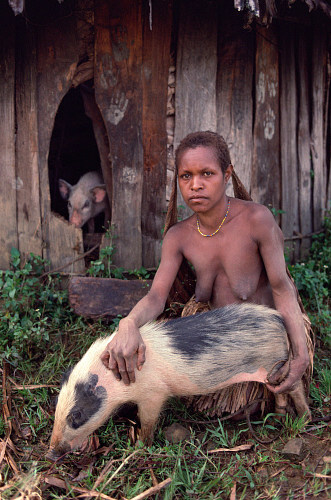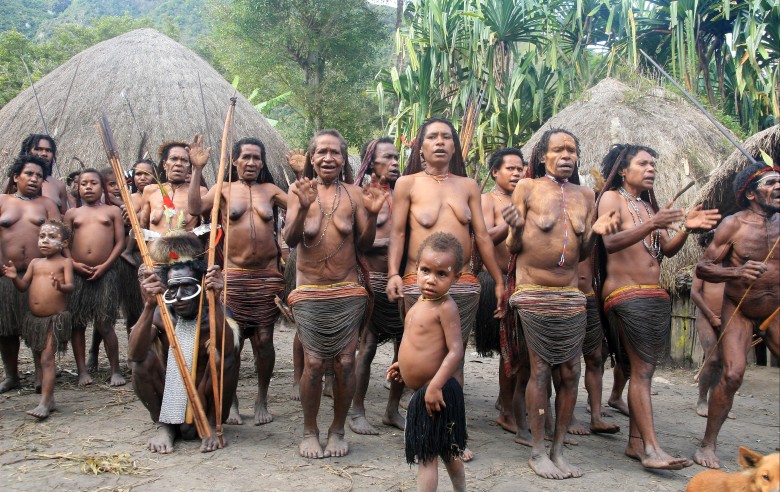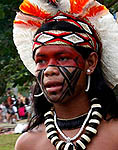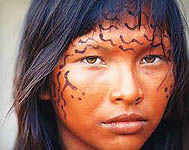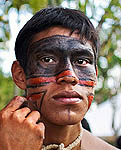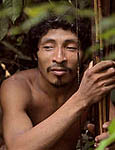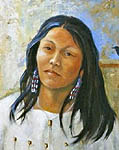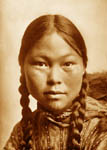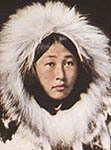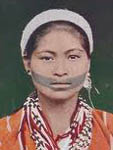MAYA-GAIA INTRODUCTION & SITEMAP Page Update 08 24 07
Note: My Anthropic Trilogy web-book, evolving since 1997, is a chronicle of my passing all considered opinion through the lens of my Nirvikalpa Samadhi with both an open-mind and healthy skepticism.
Exploring the Ancestry of Luzia of Lagoa Santa
Exploring the possibility that Luzia, (name given to the 11 KYO fossil remains of a female Homo sapiens with anomalous facial features found in a cave in the Lagoa Santa region in the state of Minas Gerais, Brazil) may represent the first amerindians whose paleolithic ancestors may be austro-melanesians who during their coastal excursion out of Africa through Indo-Malaysia over 60 KYA, interbred with Denisova hominin. The Denisovans shared East Eurasian habitat contemporary with Neanderthals whose greater range extended through westernmost Europe.
Introduction
At least two distinct groups of early humans colonized the Americas, a new study says, reviving the debate about who the first Americans were and when they arrived. Anthropoligists studied 81 skulls of early humans from the Lagoa Santa region of Brazil and found them to be different from both modern and ancient Native Americans. One skull discovered at the site, called Lapa Vermelha was given the name "Luzia". The 7,500- to 11,000-year-old remains suggest that the oldest settlers of the Americas came from different genetic stock than more recent Native Americans. Modern Native Americans share traits with Mongoloid peoples of Mongolia, China, and Siberia but researchers found many skulls from Brazil appear much more similar to modern Australians, Melanesians, and Sub-Saharan Africans.
-
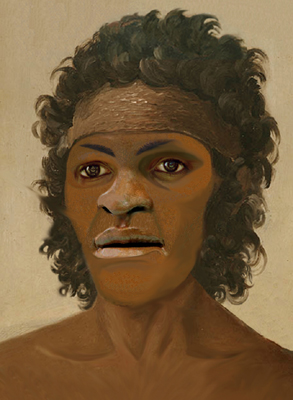 Luzia of Lagoa Santa
Luzia of Lagoa Santa
-
 Archaic Homo sapiens
Archaic Homo sapiens
-
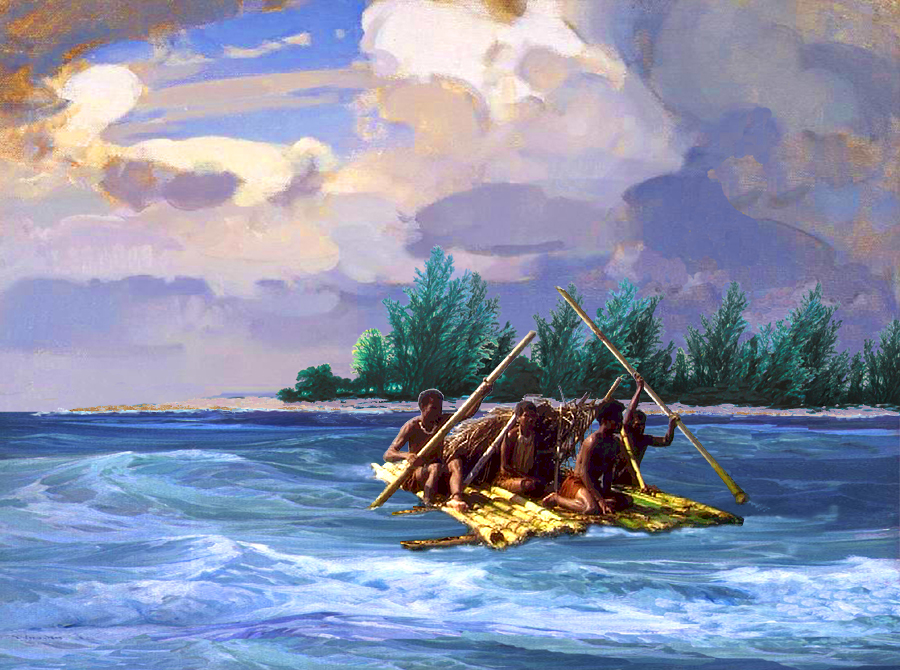 Melanesian Rafting
Melanesian Rafting
Denisova hominin or Denisovans, are Paleolithic-era members of the genus Homo that may belong to a previously unknown species of human. In March 2010, scientists announced the discovery of a finger bone fragment of a juvenile female that lived about 41,000 years ago, found in the remote Denisova Cave in the Altai mountains in Siberia, a region also inhabited at about the same time by Neanderthals and perhaps modern humans. A tooth and toe bone belonging to different members of the same population have since been found. Analysis of the mitochondrial DNA (mtDNA) of the finger bone showed it to be genetically distinct from the mtDNAs of Neanderthals and modern humans. Subsequent study of the nuclear genome from this specimen suggests this group shares a common origin with Neanderthals, they ranged from Siberia to Southeast Asia, and they lived among and interbred with the ancestors of some present-day modern humans, with up to 6% of the DNA of Melanesians and Australian Aborigines deriving from Denisovans.
The estimated average time of divergence between Denisovan and Neanderthal sequences is 640,000 years ago, and the time between both of these and the sequences of modern Africans is 804,000 years ago.
According to recent genetic studies modern humans may have mated with "at least two groups" of ancient humans: Neanderthals and Denisovans. See the National Geographic documentary video Sex in the Stone Age the Denisova story (view time- 45 min). A saga of the search for the Denisovan face featuring geneticist Svante Pääbo and paleoartist Viktor Deak
Neanderthal-Denisovan ancestors interbred with a distantly related hominin Science Advances, Alan R. Rogers*, Nathan S. Harris and Alan A. Achenbach 20 Feb 2020 - Abstract: Previous research has shown that modern Eurasians interbred with their Neanderthal and Denisovan predecessors. We show here that hundreds of thousands of years earlier, the ancestors of Neanderthals and Denisovans interbred with their own Eurasian predecessors - members of a "superarchaic" population that separated from other humans about 2 million years ago. The superarchaic population was large, with an effective size between 20 and 50 thousand individuals. We confirm previous findings that Denisovans also interbred with superarchaics, Neanderthals and Denisovans separated early in the middle Pleistocene, their ancestors endured a bottleneck of population size, and the Neanderthal population was large at first but then declined in size. We provide qualified support for the view that Neanderthals interbred with the ancestors of modern humans.
Human Evolution - The Art of John Bavaro Extrapolating the evidence for portraying Denisovan/Sapiens admixtures and extant phenotypes in Melanesians.
Ancient DNA reveals tryst between extinct human species by Gretchen Vogel - Science, 2018 - Summary: A piece of bone unearthed in a Siberian cave is providing the most direct evidence yet that groups of ancient humans met and produced offspring. The 2-centimeter fragment contained enough ancient DNA to conclude that it belonged to a woman whose mother was Neanderthal and father Denisovan, the mysterious group of ancient humans discovered in the same cave in 2011.
Denisova hominin - Neanderthal-like "sister group" bred with humans like us by Ker Than for National Geographic News, December 22, 2010. A new type of human discovered via a single pinky finger from a 40 K year old Siberian fossil points to unknown migration out of Africa. The new-human discovery implies that there was a wave of human migration out of Africa, the birthplace of humanity, that was completely unknown to science. The Denisovans- likely roamed Asia for thousands of years, probably interbreeding occasionally with humans like you and me, according to a new genetic study. "We don't think the Denisovans went to Papua New Guinea," located at the northwestern edge of the Pacific region called Melanesia, explained study co-author Bence Viola, an anthropologist at the Max Planck Institute for Evolutionary Anthropology in Leipzig, Germany. "We think the Denisovan population inhabited most of eastern Eurasia in the same way that Neanderthals inhabited most of western Eurasia," Viola said. "Our idea is that the ancestors of Melanesians met the Denisovans in Southeast Asia and interbred, and the ancestors of Melanesians then moved on to Papua New Guinea."
Denisova hominin The dominant theory holds that various hominin species left Africa in a series of distinct migrations, beginning with Homo erectus or a close relative a little under 2 million years ago, followed by the lineage that gave rise to Neanderthals, and finally the ancestors of modern humans about 50,000 years ago. The mitochondrial DNA of the Denisova hominin suggests its ancestors left Africa around 1 million years ago, at a time not previously associated with migration.
Of all the Homo sapiens that radiated out of Africa and settled into the vast regions of the Indopacific 50 kya- only the Austro-Melanesians in Mindanao Philippines and west of the Wallace Line show traces (about 6 percent) of Denisovan DNA suggesting relatives of present-day East Asians were not in Southeast Asia when the Denisova gene flow occurred.
Out of Africa - Austro-Melanesian History, Culture and Music
post by Eric Brightwell, 2010. Papua: Human remains in Papua have been dated to around 50,000 years ago.
After India, Papua may have been another major setting point for humans leaving Africa.
It was from there that people branched out into Maritime Southeast Asia.
Melanesia: The Melanesian subregion of Oceania, includes Papua, Fiji, Solomon Islands, Torres Strait Islands
and Trobriand Islands. Some of the islands were settled around 33,000 years ago via boats, and in some cases,
during interglacial periods, land bridges. For tens of thousands of years, they were the only game in town,
until, around 4,000 years ago, the Austronesians arrived, resulting in a long period of interaction that
resulted in many complex changes in genetics, languages, and culture. In the case of remote Fiji, it appears
that the Melanesians actually arrived after their neighbors, the Austronesians, around 2,500 years ago.
Luzia Did Not Die by Ana Maria Vieira 02/10/2006. Reflections of Fabricio Rodrigues dos Santos, biologist and professor at UFMG. As for Luzia, efforts were made to test her (to get her DNA analysed), however her genetic material could not be tested anymore unfortunately. Professor Sérgio Danilo Pena from UFMG tried genetic analysis but her DNA was not preserved. In the tropics, this material decomposes quicker. Rolando Gonzalez, Argentinian researcher, disclosed "unpublished data" (opining) that the morphology of Lucy is not dead. She survives in parts of Mexico and South America and Brazilian Amazon tribes - the Indians were much more heterogeneous than previously thought, and linguistic studies, archaeology and genetics, confirming the thesis that the peopling of America was at least 18,000 years. (m-g comment: But since then mtDNA technology may have advanced to provide positive results.)
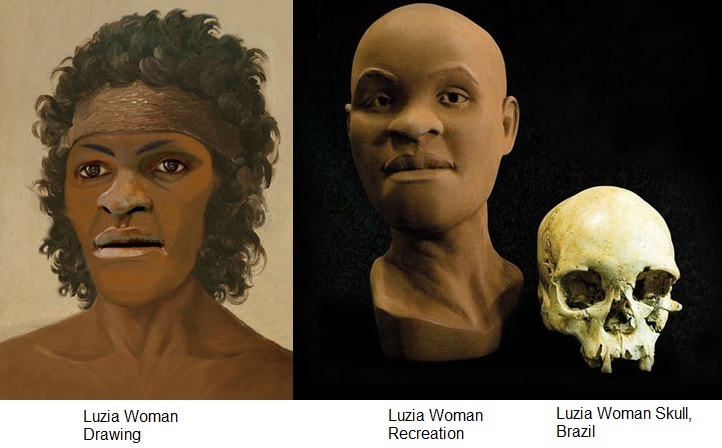 Luzia Woman Revisited
by Roberto Peron, 2017 Back in April I posted about the fossil remains of Luzia Woman found in Brazil.
In my opinion Luzia Woman has some very distinct negroid traits that suggest she could have come
from Africa or Aboriginal Australia. If she came from Australia I'm sure she came by boat across
the Pacific and if she came from Africa I'm sure she came to South America by boat across the Atlantic.
Whatever the case she does NOT look like modern Native Americans and that's a fact. The single landbridge
theory between Siberia and Alaska as being the only means to entry into the 'New World' just doesn't hold
water anymore (yes pun intended LOL).
Luzia Woman Revisited
by Roberto Peron, 2017 Back in April I posted about the fossil remains of Luzia Woman found in Brazil.
In my opinion Luzia Woman has some very distinct negroid traits that suggest she could have come
from Africa or Aboriginal Australia. If she came from Australia I'm sure she came by boat across
the Pacific and if she came from Africa I'm sure she came to South America by boat across the Atlantic.
Whatever the case she does NOT look like modern Native Americans and that's a fact. The single landbridge
theory between Siberia and Alaska as being the only means to entry into the 'New World' just doesn't hold
water anymore (yes pun intended LOL).
Skin Color Written in the DNA by Salvador Nogueira, March 2012. This study applied genomes from anonymous individuals, whose phenotypes were estimated on the basis of physical characteristics of the ethnic groups to which these individuals belonged. The researchers also analyzed the genomes of a paleo-Eskimo and four archaic hominids: three Neanderthals and one Denisovan hominid - actually, the latter was a woman that lived in Siberia forty thousand years ago, possibly belonging to a previously unknown Homo species.
There are limitations in the analysis of the genetic material of fossils. For example, it might never be possible to investigate the DNA of the first human beings who settled in what is now Brazil and who possibly crossed over the Behring Strait from Asia between 20 thousand and 12 thousand years ago. "The problem is that the climate here does not preserve the DNA in the same way as DNA is preserved in the colder climate in Europe," explains Fabricio Rodrigues dos Santos, a biologist from the Federal University of Minas Gerais. As for Luzia, the human fossil found in the 1970s by French archaeologist Annette Laming-Emperaire in Lagoa Santa, State of Minas Gerais, this is the oldest human fossil found in the Americas; archaeologists estimate that it is between 11,400 to 16,400 years old. "In the case of Luzia, I would say that analyzing her DNA is impossible; various researchers have already tried; they sent material to the United States and Europe, but were never able to generate any DNA sequencing," says Santos. Some gaps will inevitably remain, no matter how powerful genetics may be in terms of shedding light on the past of human beings, at least until the next scientific revolution. (m-g comment: It is not clear when the "DNA tests" - in the commentary by Fabricio Rodrigues dos Santos included in this 2012 article - were made as it refers only to "various researchers" which may include the same ones in his "reflections" in the Luzia Did Not Die article (above) dated 2006.)
Man's Genetic voyage - Fact, Speculation and Theories, 2011, blog post page 1-4 by SLAYER69
Update 06 26 2017:
 Denisovans in North America
First Humans [Hominin] to Arrive in North America The Denisovans 130,000 Years Ago "Researchers
digging at the Cerutti Mastodon site, an archaeological site from the early late Pleistocene epoch
near San Diego, California, found animal remains and stone tools that show the first humans [hominin]
were living in North America much earlier than previously thought." However, either critics or being
up for review, the above scenario has proven to be accurate and strong enough time-after-time to eliminate
down to zero any chance that even one member of the group who were responsible for the dissection of the
mastodon as found at the Cerutti site in San Diego, California, was a homo sapien. As is easily determined
homo sapiens, that is, modern humans, did not even emerge in Africa until 60,000 to 80,000 years ago, the
mastodon dissection site is dated at 130,000 years ago, 60,000 years before homo sapiens even existed.
End Update
Denisovans in North America
First Humans [Hominin] to Arrive in North America The Denisovans 130,000 Years Ago "Researchers
digging at the Cerutti Mastodon site, an archaeological site from the early late Pleistocene epoch
near San Diego, California, found animal remains and stone tools that show the first humans [hominin]
were living in North America much earlier than previously thought." However, either critics or being
up for review, the above scenario has proven to be accurate and strong enough time-after-time to eliminate
down to zero any chance that even one member of the group who were responsible for the dissection of the
mastodon as found at the Cerutti site in San Diego, California, was a homo sapien. As is easily determined
homo sapiens, that is, modern humans, did not even emerge in Africa until 60,000 to 80,000 years ago, the
mastodon dissection site is dated at 130,000 years ago, 60,000 years before homo sapiens even existed.
End Update
Update 01/01/2015:
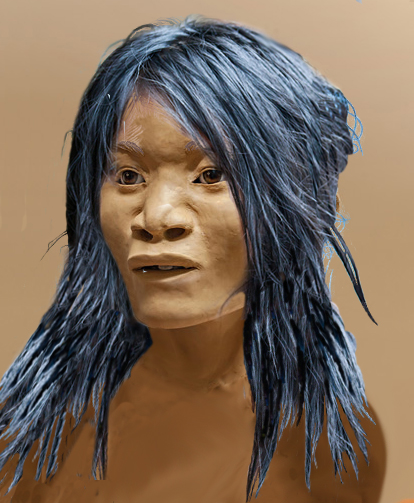 Tracking the First Americans
National Geographic Magazine Jan. 2015 by Glenn Hodges - New finds, theories, and genetic discoveries are revolutionizing
our understanding of the first Americans. The first face of the first Americans belongs to an unlucky teenage girl who
fell to her death in a Yucatán cave some 12,000 to 13,000 years ago. Her bad luck is science's good fortune. The story
of her discovery begins in 2007, when a team of Mexican divers led by Alberto Nava made a startling find: an immense
submerged cavern they named Hoyo Negro, the "black hole". At the bottom of the abyss their lights revealed a bed of
prehistoric bones, including at least one nearly complete human skeleton. See also:
video-analyses of Naia's skull
Smithsonian Magazine -
Photo Gallery -
Graphic
(comparison paleo/modern Amerindian skulls)
Tracking the First Americans
National Geographic Magazine Jan. 2015 by Glenn Hodges - New finds, theories, and genetic discoveries are revolutionizing
our understanding of the first Americans. The first face of the first Americans belongs to an unlucky teenage girl who
fell to her death in a Yucatán cave some 12,000 to 13,000 years ago. Her bad luck is science's good fortune. The story
of her discovery begins in 2007, when a team of Mexican divers led by Alberto Nava made a startling find: an immense
submerged cavern they named Hoyo Negro, the "black hole". At the bottom of the abyss their lights revealed a bed of
prehistoric bones, including at least one nearly complete human skeleton. See also:
video-analyses of Naia's skull
Smithsonian Magazine -
Photo Gallery -
Graphic
(comparison paleo/modern Amerindian skulls)
Map of Paleo Asians and Eurasians 32 KYA first settle in western Beringia - poised to migrate into the Americas.
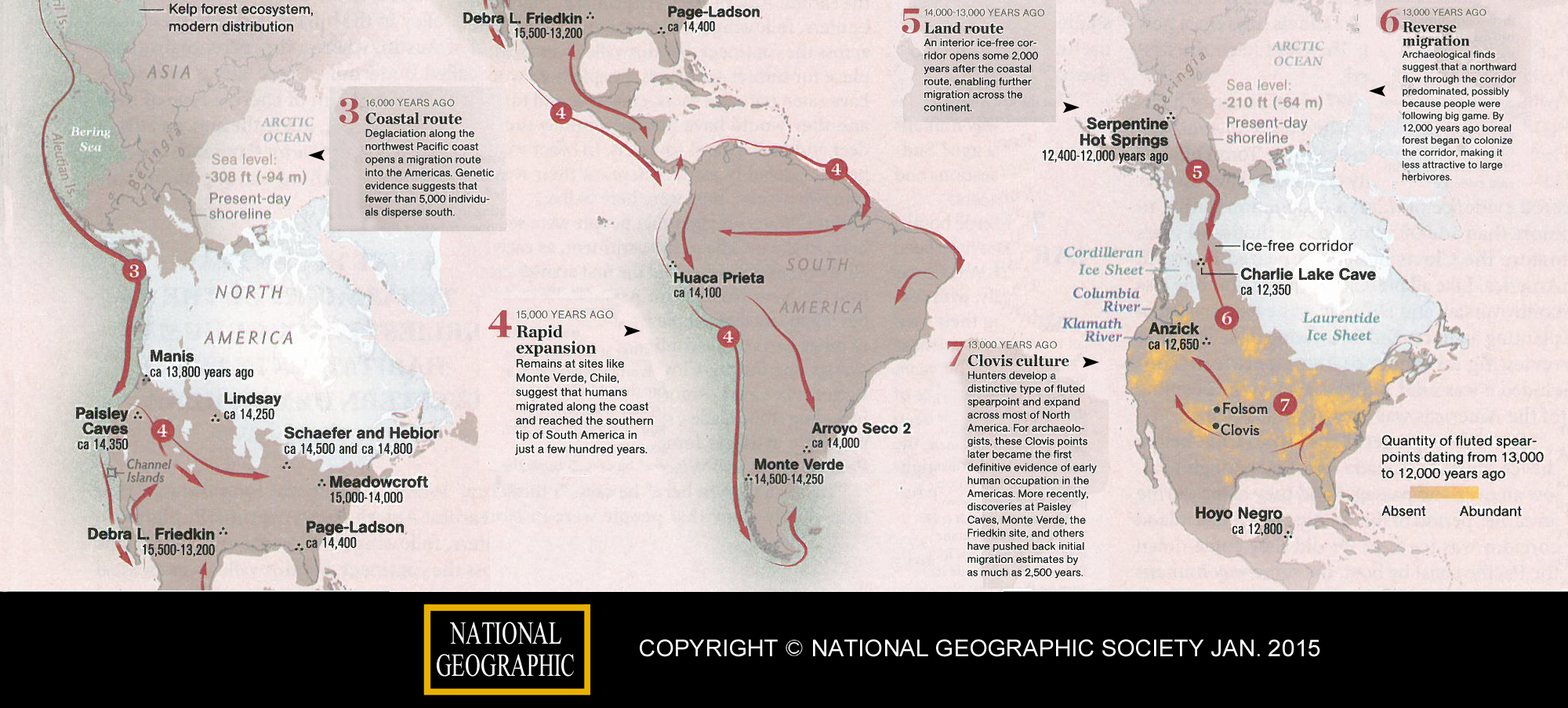 [Click on image for details]
[Click on image for details] Showing two major migrations starting with marine course 16 KYA and second overland course via ice-free corridor 14 KYA.
 Bering Land Bridge
by Scott Armstrong (Scientific American, 2014) Genetic evidence supports a theory that ancestors of Native Americans crossed Beringia and lived for 15,000
years on the Bering Land Bridge between Asia and North America until the last ice age ended. But genetic evidence shows there is no direct ancestral link
between the people of ancient East Asia and modern Native Americans. A comparison of DNA from 600 modern Native Americans with ancient DNA recovered from a
late Stone Age human skeleton from Mal'ta near Lake Baikal in southern Siberia shows that Native Americans diverged genetically from their Asian ancestors
around 25,000 years ago, just as the last ice age was reaching its peak.
Bering Land Bridge
by Scott Armstrong (Scientific American, 2014) Genetic evidence supports a theory that ancestors of Native Americans crossed Beringia and lived for 15,000
years on the Bering Land Bridge between Asia and North America until the last ice age ended. But genetic evidence shows there is no direct ancestral link
between the people of ancient East Asia and modern Native Americans. A comparison of DNA from 600 modern Native Americans with ancient DNA recovered from a
late Stone Age human skeleton from Mal'ta near Lake Baikal in southern Siberia shows that Native Americans diverged genetically from their Asian ancestors
around 25,000 years ago, just as the last ice age was reaching its peak.
Toca da Tira Peia Journal of Archaeological Science, 2013 - Brazilian site is 22,000 years ago. Toca da Tira Peia is the new name of American prehistory, providing an OSL date for the layer of scattered stone tools of c. 22,000 years BP. There are slightly older sites in North America, however they are all surrounded into some degree of controversy: Topper in South Carolina is dated to c. 23,000 cal-BP (C14) while some sites in Alberta, located in the Mackenzie "ice-free corridor" have also dates under the LGM layer (i.e. > 21 Ka BP).
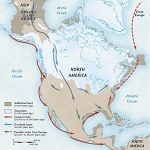 First American Debate
Ancient native boy's genome reignites debate over first Americans by Sharon Begley Reuters Feb 12, 2014 A new analysis challenges the out-of-Europe hypothesis,
which has figured in a political debate over the rights of present-day Native American tribes. Scientists announced on Wednesday that they had, for the first time,
determined the full genome sequence of an ancient American, a toddler who lived some 12,600 years ago and was buried in western Montana. His DNA, they report, links
today's Native Americans to ancient migrants from easternmost Asia.
First American Debate
Ancient native boy's genome reignites debate over first Americans by Sharon Begley Reuters Feb 12, 2014 A new analysis challenges the out-of-Europe hypothesis,
which has figured in a political debate over the rights of present-day Native American tribes. Scientists announced on Wednesday that they had, for the first time,
determined the full genome sequence of an ancient American, a toddler who lived some 12,600 years ago and was buried in western Montana. His DNA, they report, links
today's Native Americans to ancient migrants from easternmost Asia.
The Upshot of This Presentation
It does not seem too far a stretch to speculate that paleolithic austro-melanesians - descendants of interbreeding between Denisova hominin and archaic Homo sapiens - with their insatiable wanderlust and oceanic maritime skills may have continued their treking and rafting (even via extra-Beringial trans-pacific migration) to become the earliest people to populate the Americas. It seems reasonable that a state-of-art test of the Lagoa Santa fossils for Denisovan mtDNA should be a priority in researching Denisovan genetic radiation.
Update 2013: New Radiocarbon Ages of Luzia Woman Lapa Vermelha IV Site, Lagoa Santa, Minas Gerais, Brazil by Michel Fontugne, 2013 - Abstract: Luzia woman is considered one of the oldest Paleoindian skeletons found in the Americas. Luzia was found at the Lapa Vermelha IV site (Lagoa Santa, Minas Gerais, Brazil) in 1975. Recently (2011), new charcoal samples were discovered within Laming-Emperaire's correspondence and were subsequently dated by the Saclay AMS laboratory. The new results confirm the age of Luzia; however, the ages correspond to the younger part of the interval: charcoals found near Luzia's skull give an age of 10,030 ± 60 14C yr BP. End Update
Of course even if parallel research to test the most morphologicly similar extant amerindian populations fails to find any Denisovon mtDNA - Luzia's family might represent the last of their genetic population in the Americas that died out before intermixing with migrants later arriving from the North. In that event, the story of Luzia's family will just be a footnote in the pre-Columbian chapter of the epic saga of how our species evolved in Africa- then overran a perfect Earth to usher in a new geological epoch - the anthropocene and the start of a sixth major mass extinction.
-
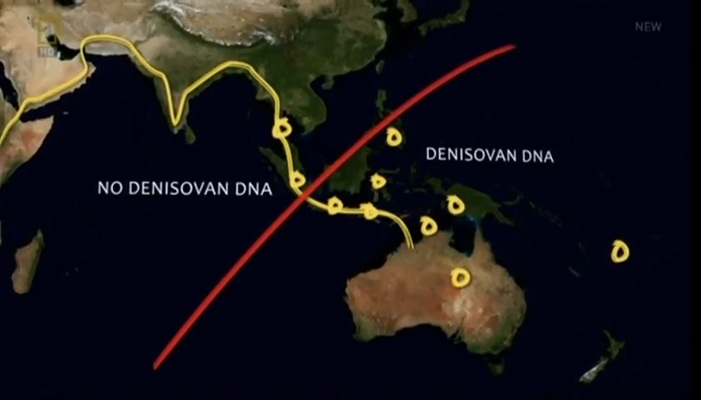 Denisovan DNA in Humans
Denisovan DNA in Humans
-
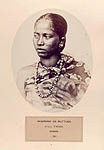 Negrito
Hilltribes India
Negrito
Hilltribes India
-
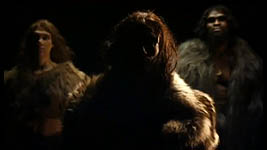 Denisovan Enigma - Viktor Deak
Homo sapiens
Denisovan Enigma - Viktor Deak
Homo sapiens
Additional References
The Colour of the Bones: scientific narratives and cultural appropriations of 'Luzia', a prehistoric skull from Brazil by Verlan Valle Gaspar Neto; Ricardo Ventura Santos, 2009 - Mana vol.5 no.se Rio de Janeiro 2011. In shifting from the scientific narratives on the Lagoa Santa skull to the media appropriations of the same, there was a substantial transformation in its nature. Many of these news stories allude to the emergence of a 'human being' who for almost 30 years was nothing more than a skull like any other. The acquisition of a name and a face transformed skeletal remains into a person. This person, Luzia, came to represent two parallel and closely connected diachronic axes: one personal, the other historico-cultural, points that we explore over the course of the text. The work also explores the sociocultural appropriations of Luzia, prompting questions about the scientific disputes surrounding the primacies and temporalities involved in the populating of the Americas and representations of prehistory, as well as the interfaces between race, science and society in contemporary Brazil. Key-words: Anthropology of Science, Palaeoanthropology, Science and the Media, Identities, Colour/Race, Brazil.
DNA Turning Human Story Into a Tell-All by Alanna Mitchell, NY Times: January 30, 2012 Faster and cheaper genetic sequencing technology, is helping scientists draw a surprisingly complex new picture of human origins. Genetic analysis of the tip of a girl's 40 kyo pinky finger found in a Siberian cave shows, modern humans encountered and bred with at least two groups of ancient humans in relatively recent times: the Neanderthals, who lived in Europe and Asia, dying out roughly 30,000 years ago, and a mysterious group known as the Denisovans, who lived in Asia and most likely vanished around the same time.
 A late Middle Pleistocene Denisovan mandible from the Tibetan Plateau
Nature (2019) Fahu Chen, et al Abstract: Denisovans are members of a hominin group who are currently only known directly from fragmentary fossils, the genomes
of which have been studied from a single site, Denisova Cave in Siberia. They are also known indirectly from their genetic legacy
through gene flow into several low-altitude East Asian populations and high-altitude modern Tibetans...Here we report a Denisovan
mandible, identified by ancient protein analysis found on the Tibetan Plateau in Baishiya Karst Cave, Xiahe, Gansu, China.
We determine the mandible to be at least 160 thousand years old through U-series dating of an adhering carbonate matrix. The Xiahe
specimen provides direct evidence of the Denisovans outside the Altai Mountains and its analysis unique insights into Denisovan
mandibular and dental morphology. Our results indicate that archaic hominins occupied the Tibetan Plateau in the Middle Pleistocene
epoch and successfully adapted to high-altitude hypoxic environments long before the regional arrival of modern Homo sapiens.
A late Middle Pleistocene Denisovan mandible from the Tibetan Plateau
Nature (2019) Fahu Chen, et al Abstract: Denisovans are members of a hominin group who are currently only known directly from fragmentary fossils, the genomes
of which have been studied from a single site, Denisova Cave in Siberia. They are also known indirectly from their genetic legacy
through gene flow into several low-altitude East Asian populations and high-altitude modern Tibetans...Here we report a Denisovan
mandible, identified by ancient protein analysis found on the Tibetan Plateau in Baishiya Karst Cave, Xiahe, Gansu, China.
We determine the mandible to be at least 160 thousand years old through U-series dating of an adhering carbonate matrix. The Xiahe
specimen provides direct evidence of the Denisovans outside the Altai Mountains and its analysis unique insights into Denisovan
mandibular and dental morphology. Our results indicate that archaic hominins occupied the Tibetan Plateau in the Middle Pleistocene
epoch and successfully adapted to high-altitude hypoxic environments long before the regional arrival of modern Homo sapiens.
Tangled Roots: Mingling among Stone Age peoples muddies human's evolutionary story by Bruce Bowers, Science News, August 25, 2012. One underdog model of human history has gotten new life. It proposes population intersections during extensive travels across ancient landscapes and regards Neandertals and Denisovans as two of possibly many subspecies gradually incorporated into a uniform, modern version of H. sapiens.
Tweeting from Denisova John Hawks (Paleoanthropologist U. of Wisconsin) Weblog on paleoanthropology, genetics and evolution. On Twitter See also The Denisova genome FAQ
Andaman Website by George Weber. Extensive information on Luzia including detail maps of Lagoa Santa archeological sites.
Genetic history of an archaic hominin group from Denisova Cave in Siberia Nature Journal, Dec. 2010, David Reich, Richard E. Green, Martin Kircher, et al. Full Aricle: Using DNA extracted from a finger bone found in Denisova Cave in southern Siberia, we have sequenced the genome of an archaic hominin to about 1.9-fold coverage. This individual is from a group that shares a common origin with Neanderthals. This population was not involved in the putative gene flow from Neanderthals into Eurasians; however, the data suggest that it contributed 4-6% of its genetic material to the genomes of present-day Melanesians.
When Did Humans Come to the Americas? Smithsonian Magazine (2013) by Guy Gugliotta - Recent scientific findings date their arrival earlier than ever thought, sparking hot debate among archaeologists. Isolated localities scattered over a broad range of North and South America have yielded archaeological and fossil evidence that suggests the "Clovis First" theory may be replaced by alternatives that propose human immigrations into the Americas preceeded classical Clovis by three thousand years or more.
Gallery of Early Amerindian Presents images of reconstruction of thirteen skulls dating between 800 and 13,000 years ago with descriptions and maps showing where found in sites in North and South America.
The vast Asian realm of the lost humans New Scientist Magazine, September 2011 by Michael Marshall. The Denisovans, mysterious cousins of the Neanderthals, occupied a vast realm stretching from the chill expanse of Siberia to the steamy tropical forests of Indonesia - suggesting the third human of the Pleistocene displayed a level of adaptability previously thought to be unique to modern humans. DNA analysis of a bone and tooth found in a Siberian cave was distinct enough from Neanderthals' to suggest tens of thousands of years of independent evolution. Before they disappeared, the Denisovans found time to interbreed with Homo sapiens. As a result, 5 per cent of the Denisovan genome lives on - not in the inhabitants of Siberia but in Papua New Guineans, living thousands of kilometers to the south-east.
Did Australian Aborigines reach America first? Cosmos Magazine 30 September 2010 by Jacqui Hayes Thursday, SYDNEY: Cranial features distinctive to Australian Aborigines are present in hundreds of skulls that have been uncovered in Central and South America, some dating back to over 11,000 years ago. Evolutionary biologist Walter Neves of the University of São Paulo, has examined these skeletons and recovered others, and argues that there is now a mass of evidence indicating that at least two different populations colonized the Americas. He and colleagues in the United States, Germany and Chile argue that first population was closely related to the Australian Aborigines and arrived more than 11,000 years ago.
Out of Africa onward to Wallacea In this paper in The American Journal of Human Genetics they extend their geographic coverage. Denisova Admixture and the First Modern Human Dispersals into Southeast Asia and Oceania: blog comment: nihonniirugaijin2008 March 15, 2012 The author's statement that Denisovans and Neanderthals could not be different "species" than Homo sapiens because they all interbred and produced fertile offspring is curious. There are many examples of "species", even those assigned to different genera, that interbreed and produce fertile offspring. Some examples are: Bottlenose Dolphin (Tursiops truncatus); False Killer Whale (Pseudorca crassidens); Polar Bear (Thalarctos maritimus); Brown Bear (Ursus arctos); Domestic cattle (Bos taurus); American Bison (Bison bison); Wolves/dogs (both Canis lupus) and Coyotes (Canis latrans); Cuban crocodile (Crocodilus rhombifer) and American crocodile (Crocodilus acutus)
Denisova Admixture and the First Modern Human Dispersals into Southeast Asia and Oceania The American Journal of Human Genetics, Volume 89, Issue 4, 516-528, 22 September 2011. Here, we quantify Denisova admixture in 33 additional populations from Asia and Oceania. Aboriginal Australians, Near Oceanians, Polynesians, Fijians, east Indonesians, and Mamanwa (a Negrito group from the Philippines) have all inherited genetic material from Denisovans, but mainland East Asians, western Indonesians, Jehai (a Negrito group from Malaysia), and Onge (a Negrito group from the Andaman Islands) have not. These results indicate that Denisova gene flow occurred into the common ancestors of New Guineans, Australians, and Mamanwa but not into the ancestors of the Jehai and Onge and suggest that relatives of present-day East Asians were not in Southeast Asia when the Denisova gene flow occurred.
Cranial morphology of early Americans from Lagoa Santa, Brazil: Implications for the settlement of the New World by Walter A. Neves and Mark Hubbe, Laboratório de Estudos Evolutivos Humanos, Universidade de São Paulo, Brazil, October 28, 2005. Our (morphology) results and interpretation are more difficult to reconcile with information coming from molecular biology. As recently summarized by several leading scholars in the field, DNA analyses (mainly mtDNA and Y chromosome) have generated very different scenarios for the occupation of the Americas. As to the number of migrations, the proposals have oscillated from one to four. As to time of entrance, figures as distant in time as 12.0 to 35.0 kyr ago have been proposed. There is, however, a recent trend toward a small number of migrations (one to two) and time depths more compatible with the archaeological findings (ca. 15 kyr). The lack of a perfect match between morphological and molecular information can be easily explained by a very frequent event in molecular evolution: loss of DNA lineages throughout time. An example of this loss is the X mitochondrial haplogroup. Nowadays it is completely absent among the Indians of South America, whereas a couple of millennia ago it could still be found in the subcontinent. More light on this subject will be certainly shed when Paleoindian DNA fragments are recovered and analyzed.
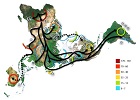 Map of Human Migration
Wikipedia - World map of human migrations, with the North Pole at center. Africa, harboring the start of the migration, is
at the top left and South America at the far right. Migration patterns are based on studies of mitochondrial (matrilinear)
DNA. Numbers represent thousand years before present. The blue line represents area covered in ice or tundra during the last
great ice age. The letters are the mitochondrial DNA haplogroups (pure motherly lineages); Haplogroups can be used to define
genetic populations and are often geographically oriented.
Map of Human Migration
Wikipedia - World map of human migrations, with the North Pole at center. Africa, harboring the start of the migration, is
at the top left and South America at the far right. Migration patterns are based on studies of mitochondrial (matrilinear)
DNA. Numbers represent thousand years before present. The blue line represents area covered in ice or tundra during the last
great ice age. The letters are the mitochondrial DNA haplogroups (pure motherly lineages); Haplogroups can be used to define
genetic populations and are often geographically oriented.
The Pre-Clovis and Clovis World by Mike Ruggeri. A compendium of references to amerindian anthropology, archaeology, genetics and migration.
Denisovan Admixture - The Erectus Within? More caveman admixture in modern humans, especially Melanesians! (Discover Magazine 2012 - Gene Expression blog) A new paper on archaic adaptive introgression among Melanesians is worth reviewing, because it's probably a foretaste of what's to come. Researchers are combing through the human genome, as more and more genomes come on line, in the search of weird and unexpected variation. The paper is in Molecular Biology and Evolution, and is abstracted at Global genetic variation at OAS1 provides evidence of archaic admixture in Melanesian populations. The two primary figures from this paper do a good job of illustrating the main result: The first figure is a phylogenetic tree of haplotypes at the OAS1 locus, with pie charts showing the proportion of individuals from a set of populations which contribute to the total number for that haplotye. So you see that the "deep lineage" is relatively distant from a cluster of other haplotypes (as measured by mutational differences which are proportional to depth of common ancestry), and, that deep linage is exclusively found in Papuans in this set. The second figure shows the frequency of the deep lineage haplotype over a larger set of populations. I cut off the section which shows that Africans are at zero percent. The haplotype is found almost exclusively in Melanesian populations, except for the fact out of over 200 South Asians they sampled, 3 of them carried it (2 Pakistanis, 1 Sri Lankan). Massive Neandertal & Denisovan introgression by Razib Khan January 2012. (Another article in same website) John Hawks' lab is working in the same area, and he disagrees with the specific results presented (above) - so claimed Peter Parham at a Royal Society meeting last week - Human evolution, migration and history revealed by genetics, immunity and infection. You can actually listen to the talk by pulling down the mp3 file. To get the part about human evolution and introgression, jump to 24 minutes in. Here is the general sketch: It looks like ~50 percent of the HLA Class I alleles in Europeans derive from Neandertals, ~70-80 percent of HLA Class I alleles in East Asians derive from Denisovans, and that and ~90-95 percent of HLA Class I alleles in Papuans derive from Denisovans. If you recall, ~2.5% of the total genome content of non-Africans seems to be Neandertal, while ~5% of the total genome content of Papuans seems to be Denisovan. The total genome content proportions are rough estimates, there may be some wiggle room in there. But you can see that the HLA allele admixture estimates from these ancient Eurasian lineages is greater by an order of magnitude.
Stone Age toe could redraw human family tree - by Colin Barras, New Scientist August 2011. The Denisova cave had already yielded a fossil tooth and finger bone, in 2000 and 2008. Last year, Svante Pääbo's DNA analysis suggested both belonged to a previously unknown group of hominins, the Denisovans. The new bone, an extremely rare find, looks likely to belong to the same group. The Neanderthals came to the Altai mountains [in Siberia] about 45,000 years ago and were probably assimilated by the native Denisovan population - it cannot be excluded that the individual was Denisovan, Neanderthal or even a hybrid.
'Denisovan' admixture widespread beyond Wallace Line, non-existant elsewhere An exchange between two posters (same guys as in link below). Re: finding by Reich et al. Melanesians of all modern humans researched back in the day were the only ones to show admixture with the mysterious Denisova finger. Back in Christmas I said that this admixture was not with Denisovans as such but a related species (probably H. erectus) of which the Denisova hominins were just the tip of the iceberg and a Neanderthal-admixed tip actually. I proposed that the admixture shown by Melanesians but not continental Eurasians was probably the product of admixture with H. erectus solensis (or something like that) in Indonesia, while 'Denisovans' were hybrids of H. erectus and H. neanderthalensis, possibly at near 50% levels.
Sunda and Sahul Migration Extensive blog discussion about origins and migration of haplogroups among S.E. Asia Sunda, Sahul, Wallacea/Sahul, Indonesia, Indo-Pacific, Melanesian Neolithic, Malay, Papua, etc. If Australia was first reached from Timor, as seems likely, then a final sea crossing of about 55 miles, involving movement out of sight of land, would also have been required. That's why I strongly suspect that the crossing to Sahul wasn't made from Timor, but from Halmahera to what is now New Guinea. Indeed, on Java new dates from the Ngandong and Sambungmacan sites suggest that Homo erectus may have survived far longer than previously believed, perhaps to as recently as 25,000 years ago.
Map Interglacial Landbriges showing Sunda (Indo Malayan and S.E. Asia mainland) and Sahul (Austro Malayan - West of Wallace Line) See also map of interglacial migration routes
Ancient humans, dubbed 'Denisovans', interbred with us By Pallab Ghosh Science correspondent, BBC News 2010 Professor Chris Stringer of the Natural History Museum in London believes it is because there may have been only a fleeting encounter as modern humans migrated through South-East Asia and then on to Melanesia. "It could be just 50 Denisovans interbreeding with a thousand modern humans. That would be enough to produce this 5% of those archaic genes being transferred."
The Diverse Faces of Melanesia Thread in forumbiodiversity - Anthropology Biodiversity Forum - detailing the distinction of Melanesia from Oseania with portraits of native people. Melanesia is a subregion of Oceania extending from the western end of the Pacific Ocean to the Arafura Sea, and eastward to Fiji. The region comprises most of the islands immediately north and northeast of Australia. The name Melanesia was first used by Jules Dumont d'Urville in 1832 to denote an ethnic and geographical grouping of islands distinct from Polynesia and Micronesia. Melanesians, together with Papuan people and Australian Aborigines, are the only known modern humans whose prehistoric ancestors interbred with the Denisova hominin, sharing 4% -6% of their genome with this ancient human species.
A Winters Tale West Papua IV - From Highland to Lowland. For the final section of time in Papua the plan was to follow the pioneering route of Austrian explorer Heinrich Harrer to the remote 'Jae-Li-Me' stone axe quarries and neolithic peoples written about in his book 'I Come From The Stone Age.
Philippine Negritos The first People to come to the Philippines were the Atis or Aetas. They came across land bridges from mainland Asia about 25,000 years ago that rising sea levels later covered. Today, there are still Negritos in the hills of Zambales. The Ati is a Negrito ethnic group in Panay in the central islands of the archipelago, genetically-related to other Negrito ethnic groups in the Philippines such as the Aeta of Luzon, the Batak of Palawan, and the Mamanwa of Mindanao.
A rare genomic look at Aboriginal Australians 2010, Dienekes Anthropology Blog presents a book-length chronicle of scholastic commentary relating to race, subspecies, ethnicity, origins, admixture, etc. of austro-melanesian-oceania aboriginal Homo sapiens.
Alternative History of Australians and Polynesians - derived from linguistics: The Austronesian-speaking peoples are various populations in Southeast Asia and Oceania that speak languages of the Austronesian family. They include Taiwanese aborigines; the majority ethnic groups of East Timor, Indonesia, Malaysia, the Philippines, Brunei, Madagascar, Micronesia, and Polynesia, as well as the Polynesian peoples of New Zealand and Hawaii, and the non-Papuan people of Melanesia. For the past 100 years or so, the Saisiyat tribe of Taiwan has performed the songs and rites of a festival to keep alive the spirit of a race of people who are said to have preceded all others in Taiwan, and which they exterminated. In fact, the short, black men the festival celebrates are one of the most ancient types of modern humans on this planet and their kin still survive in Asia today. They are said to be diminutive Africoids and are variously called Pygmies, Negritos and Aeta. They are found in the Philippines, northern Malaysia, Thailand, Sumatra in Indonesia and other places.
Melanesia History newworldencyclopedia.com - Melanesia has been the site of human habitation for tens of thousands of years. The first pre-European inhabitants of the Torres Strait Islands are believed to have migrated from the Indonesian archipelago 70,000 years ago when New Guinea was still attached to the Australian continent. New Guinea's first inhabitants arrived around 40,000 years ago, having traveled through the southeast Asian peninsula; they developed one of the earliest known agricultures. A later wave of Austronesian people, from Taiwan, brought ocean-voyaging skills. The Maluku Islands have been occupied for 32,000 years, as have the Bismarck Archipelago and the Solomon Islands.
Melanesians Wikipedia
Oceania Ethnology The aboriginal Negroid Papuans, who occupied most of New Guinea, differ from the modified Melanesians of its eastern shores in many aspects of social customs, arts and crafts. The Papuans are more individualistic and democratic; they live in small, independent village communities, whose leader or headman does not submit to an hereditary territorial chieftain. They lack a comprehensive understanding of a universe and its controlling gods, and thus have no priesthood; tapu, too, is of little importance to them.
Trobriands Islands (Subscription Archives) National Geographic July 1992, Under the Spell of the Trobrian Islands by Paul Theroux See also: The Happy Isles of Oceania by Paul Theroux
New Hebrides (Taboos and Magic Rule Namba Lives) National Geographic Jan 1972, by Kal Muller - Revealing account of the remnants of paleolithic culture among the Malekula - the most traditional of the various melanesian tribes in the New Hebrides Islands. See also: New Hebrides People and Culture The Geographical Journal Vol. 88, No. 4 (Oct., 1936) by T. H. Harrisson
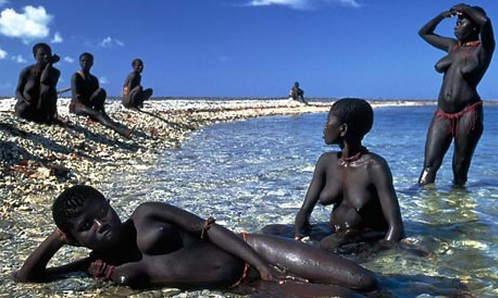 Out of Africa - Austro-Melanesian History, Culture and Music
A post by Eric Brightwell, 2010. An illustrated synopsis of Homo sapiens migration out of Africa to populate the
Indo-Malayan and Austro-Malayan regions of S.E. Asia. The Great Andamanese, Jarawa, Jangil, Onge, and Sentinelese
probably represent the purest example of Africa's original pioneers in Asia. (Image on right of Jarawa by
Olivier Blaise.)
Out of Africa - Austro-Melanesian History, Culture and Music
A post by Eric Brightwell, 2010. An illustrated synopsis of Homo sapiens migration out of Africa to populate the
Indo-Malayan and Austro-Malayan regions of S.E. Asia. The Great Andamanese, Jarawa, Jangil, Onge, and Sentinelese
probably represent the purest example of Africa's original pioneers in Asia. (Image on right of Jarawa by
Olivier Blaise.)
Descendents of Early Immigrants India moamuria and muttuck hilltribe Assam, India.
Links about the Current Status of Indigenous People in South America
With videos and illustrations that reveal a trend for some tribes to have distinctive facial characteristics with less of the widespread asian/amerindian mongoloid traits and more closely resemble subtle features of the Luzia reconstruction.
Amazon Indians A comprehensive, illustrated, documentation portraying the aboriginal tribes of Western Amazonia - a people who appear morphologicly and genetically derived from the continuum of neolithic Siberian ancestors who populated the Americas via Beringia during the last ice age around 10 kya.
Survival International
Organization advocating for the protection of indigenous people worldwide. This link relates to the uncontacted tribes in Brazil.
Isolated Nomads Are Under Siege in the Amazon Jungle Protected forests in Brazil and Peru hold some of the world's last remote indigenous groups, increasingly threatened by resource-hungry outsiders. by Scott Wallace and Chris Fagan Photos by Charlie Hamilton James (October 2018 National Geographic magazine) Along with the forests, the wild game that has sustained the Guajajara's hunting culture for generations is vanishing. The lakes that give birth to their rivers and streams are drying up because of deforestation. Fish and birds are dying off. Going after illegal loggers here has become the hallmark of patrols like this. They belong to a hundred-member, homegrown force of indigenous volunteers who call themselves the Forest Guardians. This group and others like it have sprouted up in recent years to meet a rising tide of illegal logging that is decimating protected woodlands in the eastern Amazonian state of Maranhão, including the 1,600-square-mile Arariboia Indigenous Land.
Far more dire is the plight of another tribe, with which they share the Arariboia reserve: the Awá. Several bands of Awá nomads - the easternmost isolated, or "uncontacted", people in the Amazon - roam the woodlands in the core of the territory, living in a state of near-constant flight from the whine of winches and chain saws and, in the dry season, the smoke of wildfires.
Wildest Place on Earth National Geographic Magazine, January, 2013 Demand for oil is squeezing the life out of Ecuador's Yasuni National Park and the nomadic way of the Taromenane and Tagaeri groups of the Waorani (Huaorani or Waodani, also known as the Waos) who live in voluntary isolation in the so-called - Zona Intangible - Untouchable Zone, theoretically prescribed to protect them.
 Indigenous People
Many parts of the Americas are still populated by indigenous Americans; some countries have sizable populations, especially
Bolivia, Peru, Mexico, Guatemala, Colombia, and Ecuador. At least a thousand different indigenous languages are spoken in
the Americas. Some, such as Quechua languages, Aymara, Guaraní, Mayan languages, and Nahuatl, count their speakers in
millions. Many also maintain aspects of indigenous cultural practices to varying degrees, including religion, social
organization and subsistence practices. A 2007, FUNAI report confirmed the presence of 67 different uncontacted tribes
in Brazil, up from 40 in 2005. With this addition Brazil has now surpassed New Guinea as the country having the largest
number of uncontacted peoples.
Indigenous People
Many parts of the Americas are still populated by indigenous Americans; some countries have sizable populations, especially
Bolivia, Peru, Mexico, Guatemala, Colombia, and Ecuador. At least a thousand different indigenous languages are spoken in
the Americas. Some, such as Quechua languages, Aymara, Guaraní, Mayan languages, and Nahuatl, count their speakers in
millions. Many also maintain aspects of indigenous cultural practices to varying degrees, including religion, social
organization and subsistence practices. A 2007, FUNAI report confirmed the presence of 67 different uncontacted tribes
in Brazil, up from 40 in 2005. With this addition Brazil has now surpassed New Guinea as the country having the largest
number of uncontacted peoples.
Indigenous People Brazil At the time of European discovery, some of the indigenous peoples were traditionally mostly semi-nomadic tribes who subsisted on hunting, fishing, gathering, and migrant agriculture. Many of the estimated 2,000 nations and tribes which existed in the 16th century died out as a consequence of the European settlement, and many were assimilated into the Brazilian population.
 Lost Tribes of the Amazon
Smithsonian Magazine by Sidney Posuello - Photos: Nicolas Reynard. Featuring
Scott Wallace's efforts
to protect 'recently-contacted' tribes in the Vale do Javari Indigenous Area - the Matis, the Flecheiros (the arrow people) and the Korubo (the head bashers) who killed 3 FUNAI workers for reasons unknown (image right).
Lost Tribes of the Amazon
Smithsonian Magazine by Sidney Posuello - Photos: Nicolas Reynard. Featuring
Scott Wallace's efforts
to protect 'recently-contacted' tribes in the Vale do Javari Indigenous Area - the Matis, the Flecheiros (the arrow people) and the Korubo (the head bashers) who killed 3 FUNAI workers for reasons unknown (image right).
Out of Time by Paul Raffaele - Smithsonian Magazine, April 2005. Less than a decade after their first contact with the outside world, the volatile Korubo of the Amazon still live in almost total isolation. Their fiercest champion, Indian tracker Sydney Possuelo, is trying to keep their world intact. When at last we come face to face with the Korubo in the sun-dappled clearing, about the size of two football fields and scattered with fallen trees, Jumi and Jemi grasp their rifles, warily watching the men with their war clubs. The Korubo stand outside a maloca, a communal straw hut built on a tall framework of poles and about 20 feet wide, 15 feet high and 30 feet long.
Indigenous Territory In Brazil, Indigenous Territories are areas inhabited and exclusively possessed by indigenous people. The Brazilian Constitution recognizes the inalienable right of indigenous peoples to lands they "traditionally occupy" and automatically confers them permanent possession of these lands. In practice, however, a formal process of demarcation is required to gain full protection, and often entails protracted legal battles. Even after designation, they are frequently subject to illegal invasions by settlers and mining and logging companies. There are 672 Indigenous Territories in Brazil, administered by FUNAI, the Brazilian government Indian Agency, covering about 13% of the country's land area.
FUNAI Marãiwatsédé Indigenous Plan 2012, Documentation of history with Day of the Indian and other videos and images of the FUNAI disengagement plan of non-indian populations from the Marãiwatsédé, Indigenous Territory in the northeastern region of the State of Mato Grosso, Brazil.
Indigenous Peoples of Brazil An extensively illustrated travel guide and selective history resource compiled by Indonesian blogger Rama Yappy Kawitarka. See also: Brazilian Beauty: The Threatened Atlantic Forest; Can World's 'Most Threatened' Tribe Be Saved?; Isolated Peru tribe makes uncomfortable contact; Concerns swirl over safety of 'uncontacted Amazonian tribe; etc.
Indigenous Olympic Games, Brazil
A travel account at the Indigenous Olympic Games in Port Seguro, Bahia State, Brazil (Adjacent North of Minas Gerais State where Lagoa Santa located) Nov 20, 2004 by Alann de Vuyst (composed and enriched by Emmanouil Lalaios, Fellow of the Royal Geographical Society) Coroa Vermelha, the place where the Pataxo live and the best beaches are.
The Maroons of Brazil National Geographic Magazine, Sept, 2012 - By Charles C. Mann and Susanna Hecht - Photograph by Tyrone Turner. Since the 17th century, escaped slaves in Brazil created thousands of hidden societies, or quilombos, in the heart of the country. Throughout the world, by the tens of thousands, African slaves escaped the harsh conditions of the colonial plantations and mining operations and headed for the interior, into lands controlled by indigenous people. Ex-slaves and aboriginals fashioned hybrid settlements known as maroon communities, after the Spanish cimarrón, or runaway. In Brazil the complex interplay between black and red is a hidden drama that historians and archaeologists have just begun to unravel as new laws are giving maroons a key role in determining the future of the great Amazon forest. The stakes are high as thousands of maroon communities are emerging from the shadows, reaffirming their mixed culture and pressing for legal title to the land they have occupied since the era of slavery.
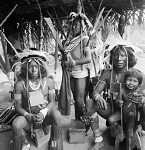 Life In The Shadows
- Slavery and Slave Culture in Colonial Dutch Surinam (book blog by an anonymous Dutch lady) 2008 Chapter 14: To rise or not to rise. An intimate historical documentation of the dynamics among the escaped African slaves, the indigenous native population and the colonial plantation hegemony in 18th century Dutch Surinam that suggest the interplay in maroon communities throughout the Americas and Brazil in particular. The early weglopers would probably have perished in large numbers if the Indians had not aided them. During the Indian War, they collaborated on many levels and one group of runaways even amalgamated with Indians to form the so-called Karboegers van de Coppename. Some groups of Indians also took in runaways in later times and intermarried with them. Since the former slaves were often stronger and more ferocious than their hosts, some of them rose to prominent positions within the Indian tribes.
Life In The Shadows
- Slavery and Slave Culture in Colonial Dutch Surinam (book blog by an anonymous Dutch lady) 2008 Chapter 14: To rise or not to rise. An intimate historical documentation of the dynamics among the escaped African slaves, the indigenous native population and the colonial plantation hegemony in 18th century Dutch Surinam that suggest the interplay in maroon communities throughout the Americas and Brazil in particular. The early weglopers would probably have perished in large numbers if the Indians had not aided them. During the Indian War, they collaborated on many levels and one group of runaways even amalgamated with Indians to form the so-called Karboegers van de Coppename. Some groups of Indians also took in runaways in later times and intermarried with them. Since the former slaves were often stronger and more ferocious than their hosts, some of them rose to prominent positions within the Indian tribes.
Uncontacted Peoples Worldwide - also referred to as isolated peoples or lost tribes, are communities who live, or have lived, either by choice (peoples living in voluntary isolation) or by circumstance, without significant contact with globalized civilization. Few people have remained totally uncontacted by global civilization. Indigenous rights activists call for such groups to be left alone, stating that it will interfere with their right to self-determination. Most uncontacted communities are located in densely forested areas in South America and New Guinea. Knowledge of the existence of these groups comes mostly from infrequent and sometimes violent encounters with neighboring tribes, and from aerial footage. Isolated tribes may lack immunity to common diseases, which can kill a large percentage of their people after contact.
Some Comparative Aboriginal Faces From Outside South America
Links Referencing Trans-Pacific Migration and Modern and Ancient Expeditions in Oceangoing Rafts and Canoes
Transpacific Migrations An in-depth compendium examining alternative theories about how the first neolithic amerindians populated the New World. The discovery of human remains at older, so-called Pre-Clovis sites in both North and South America has raised questions about the "Clovis-First" and Beringia Land Bridge theories.
 The Kennewick Man
Finally Freed to Share His Secrets
by Douglas Preston (Smithsonian Magazine, 2014) He's the most important human skeleton ever found in North America- and here, for the first time, is his story as documented in the booK
Kennewick Man:
The Scientific Investigation of an Ancient American Skeleton
by (Editors) Douglas W. Owsley, Richard L. Jantz, 2014 The book recounts the history of discovery, presents a complete inventory of the bones and explores every angle of what they may reveal. In the book, we now have an idea who Kennewick Man was, how he lived, what he did and where he traveled. We know how he was buried and then came to light. Kennewick Man, Owsley believes, belongs to an ancient population of seafarers who were America's original settlers. They did not look like Native Americans. The few remains we have of these early people show they had longer, narrower skulls with smaller faces. These mysterious people have long since disappeared. Judging from the shape of his skull and bones, his closest living relatives appear to be the Moriori people of the Chatham Islands, a remote archipelago 420 miles southeast of New Zealand, as well as the mysterious Ainu people of Japan - Just think of polynesians. Sometime around 15,000 years ago, the new theory goes, coastal Asian groups began working their way along the shoreline of ancient Beringia - a route labled "the kelp highway".
The Kennewick Man
Finally Freed to Share His Secrets
by Douglas Preston (Smithsonian Magazine, 2014) He's the most important human skeleton ever found in North America- and here, for the first time, is his story as documented in the booK
Kennewick Man:
The Scientific Investigation of an Ancient American Skeleton
by (Editors) Douglas W. Owsley, Richard L. Jantz, 2014 The book recounts the history of discovery, presents a complete inventory of the bones and explores every angle of what they may reveal. In the book, we now have an idea who Kennewick Man was, how he lived, what he did and where he traveled. We know how he was buried and then came to light. Kennewick Man, Owsley believes, belongs to an ancient population of seafarers who were America's original settlers. They did not look like Native Americans. The few remains we have of these early people show they had longer, narrower skulls with smaller faces. These mysterious people have long since disappeared. Judging from the shape of his skull and bones, his closest living relatives appear to be the Moriori people of the Chatham Islands, a remote archipelago 420 miles southeast of New Zealand, as well as the mysterious Ainu people of Japan - Just think of polynesians. Sometime around 15,000 years ago, the new theory goes, coastal Asian groups began working their way along the shoreline of ancient Beringia - a route labled "the kelp highway".
Ancient DNA Links Native Americans With Europe Science, 2013 by Michael Balter. Where did the first Americans come from? Most researchers agree that Paleoamericans moved across the Bering Land Bridge from Asia sometime before 15,000 years ago, suggesting roots in East Asia. But just where the source populations arose has long been a mystery. Now comes a surprising twist, from the complete nuclear genome of a Siberian boy who died 24,000 years ago - the oldest complete genome of a modern human sequenced to date. His DNA shows close ties to those of today's Native Americans. Yet he apparently descended not from East Asians, but from people who had lived in Europe or western Asia. The finding suggests that about a third of the ancestry of today's Native Americans can be traced to "western Eurasia"...
Paul Rivet New world encyclopedia: Paul Rivet (May 7, 1876 - March 21, 1958) was a French ethnologist and physical anthropologist, famous for his theory that Asia was the cradle of the American man, but that the first inhabitants of South America did not come from the north through Beringia, but through Australia and Melanesia and trans-pacific migration, some 6,000 years ago. Evidence supposedly supporting this theory includes cave paintings in Serra da Capivara National Park in Brazil, limestone caves of Lagoa Santa region in central Brazil, the Fuegians of Tierra del Fuego, and the Kennewick Man, whose remains were found in Washington State. These all suggest that early humans traveled across the Pacific Ocean from Asia and Oceania to America during a time when inland routes were blocked by ice. Among the scientists who have supported the theory of the Australian migrations are Mendes Correa and George Montandon.
 Homo erectus Rafting
2009, Well-illustrated speculative documentary about H. erectus rafting from Timor in Indonesia to venture into areas of open ocean between the eastern edge of Sunda and the western edge of Australasia throughout the late Pliocene and Pleistocene. Includes description and links to
The First Mariners Project
by Robert G. Bednarik - which investigates the Pleistocene origins of seafaring. The project comprises a series of archaeological studies and replicative expeditions with primitive vessels in specific parts of the world. Its purpose is to determine the minimum technological requirements to cross those sea barriers humans have successfully crossed during the Ice Age, to acquire a reliable measure of human technological and cognitive competence at the time in question. Illustrations of The Nale Tasih 2, a bamboo raft made with stone tools, on its epic 13-day journey from Timor to Australia, December 1998.
Homo erectus Rafting
2009, Well-illustrated speculative documentary about H. erectus rafting from Timor in Indonesia to venture into areas of open ocean between the eastern edge of Sunda and the western edge of Australasia throughout the late Pliocene and Pleistocene. Includes description and links to
The First Mariners Project
by Robert G. Bednarik - which investigates the Pleistocene origins of seafaring. The project comprises a series of archaeological studies and replicative expeditions with primitive vessels in specific parts of the world. Its purpose is to determine the minimum technological requirements to cross those sea barriers humans have successfully crossed during the Ice Age, to acquire a reliable measure of human technological and cognitive competence at the time in question. Illustrations of The Nale Tasih 2, a bamboo raft made with stone tools, on its epic 13-day journey from Timor to Australia, December 1998.
Ancient Transpacific Influence On the New World Recent Developments by Bruno J. Mittler and Judy K. Pruden, 1966. The intent of this paper is to discuss the possibility of transpacific contact in pre-Columbian times. It deals with the problem of ancient transpacific movements based on archaeological findings of ancient Old World traits in the New World that suggest the displacement - either intentional or accidental - of people across the Pacific Ocean. Our central purpose is to discuss the possibility of evidence for a transpacific movement of some ancient Japanese fishing people of the coast of Japan to the coast of Ecuador.
Kon-Tiki in Reverse: The Story of the Tahiti-Nui Expedition of Eric de Bisschop He was determined to disprove the suggestion that Polynesian's could not have reached the shores of South America because the prevailing winds and currents would have effectively prevented such a passage. For long-distance voyages of exploration and colonization, with their essential cargoes of people and provisions, only large rafts would suffice - and as de Bisschop saw it, when equipped with the moveable centerboards called guaras, these rafts became sailing vessels capable of true navigation. After 6 months at sea, the raft plowed on to its farthest point east: 87° 54'W. Winds then forced it back more than a degree to the west, where a Chilean naval vessel caught up with it on May 22, 1957. The unsuccessful tow resulted in the final break-up and abandonment of the raft on May 26th.
Update July 10, 2020: Polynesians, Native Americans met and mingled long ago by Lizzie Wade Science July 10 2020 - Summary: By about 1200 C.E., Polynesians were masters of oceanic exploration, roaming 7000 kilometers across the Pacific Ocean in outrigger canoes to reach and settle islands from New Zealand to Rapa Nui, or Easter Island, the closest Polynesian island to South America. So it's natural to wonder: Did these world-class explorers make it the last 3800 kilometers to South America? A genomic study of more than 800 modern Polynesians and Native Americans suggests they did. The work strengthens earlier evidence that somewhere - perhaps on the northern coast of South America - the two groups met and mixed well before the era of European colonialism. And it shakes up the most popular model of where Native American genes first took root in Polynesia, shifting the focus from Rapa Nui to islands farther west. End Update
From China to America: The Story of the Hsu-Fu Expedition by Torgeir Saeverud Higraff with Betty Blair. In the early 1990s, Irish explorer Tim Severin revived an old hypothesis that Chinese mariners might have reached the Americas two thousand years ago. One thousand miles from the American coast, and nearly 4,000 miles from Japan, the crew watched as several bamboo logs dislodged and drifted away. The raft was breaking up underneath them. After more than 100 days at sea, the crew now noticed that teredos were finally making their appearance as well, eating their way through the bamboo. With his voyage of 6,500 miles on a bamboo raft, Tim Severin had set a new standard for all future archaeological experiments.
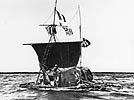 Kon Tiki
Kon-Tiki was the raft used by Norwegian explorer and writer Thor Heyerdahl in his 1947 expedition across the Pacific Ocean from South America to the Polynesian islands. Heyerdahl believed that people from South America could have settled Polynesia in pre-Columbian times, although most anthropologists now believe they did not. His aim in mounting the Kon-Tiki expedition was to show, by using only the materials and technologies available to those people at the time, that there were no technical reasons to prevent them from having done so. Although the expedition carried some modern equipment, such as a radio, watches, charts, sextant, and metal knives, Heyerdahl argued they were incidental to the purpose of proving that the raft itself could make the journey.
Kon Tiki
Kon-Tiki was the raft used by Norwegian explorer and writer Thor Heyerdahl in his 1947 expedition across the Pacific Ocean from South America to the Polynesian islands. Heyerdahl believed that people from South America could have settled Polynesia in pre-Columbian times, although most anthropologists now believe they did not. His aim in mounting the Kon-Tiki expedition was to show, by using only the materials and technologies available to those people at the time, that there were no technical reasons to prevent them from having done so. Although the expedition carried some modern equipment, such as a radio, watches, charts, sextant, and metal knives, Heyerdahl argued they were incidental to the purpose of proving that the raft itself could make the journey.
Speculations About Polynesian Origins and Migration
Detailed genetic and phylogenic evidence for expansive theory of global radiation of Polynesian ancestry from Southern China and Japan to
Canada/Hawaii/Melanesia/Americas/North Africa/Atlantis/etc.
Consensus reality:
Polynesian Migration Routes
PBS version of Polynesian migrations based on archaeological evidence. The Marquesas Islands were reached between 200 BC and 300 AD,
and although the evidence is so far lacking, some archaeologists believe that the Cook and Society Islands may have been settled from
West Polynesia even earlier. Then, from this nuclear region of East Polynesia, voyagers explored the length and breadth of the Polynesian
triangle, reaching the distant islands of Hawaii (by at least 400-500 AD), Easter Island (by about 400 AD), and New Zealand
(around 1000 AD) to complete the settlement of Polynesia.
or maybe not!
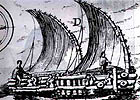 The Manteño Expedition
Group replicates rafts built by the Manteño amerindians. The Manteño were a West-Ecuadorean maritime culture flourishing between the 800's AD -- when Europe was being ransacked by the Vikings -- and the time of the Spanish conquistadores, who arrived in 1526 AD. The project has experimented with a wide variety of design ideas over the years, but all the rafts we've built have shared a few basic characteristics: They're big. A balsa raft is an immense sailing barge, measuring sometimes as much as 60 feet in length and weighing 35,000 pounds.
The Manteño Expedition
Group replicates rafts built by the Manteño amerindians. The Manteño were a West-Ecuadorean maritime culture flourishing between the 800's AD -- when Europe was being ransacked by the Vikings -- and the time of the Spanish conquistadores, who arrived in 1526 AD. The project has experimented with a wide variety of design ideas over the years, but all the rafts we've built have shared a few basic characteristics: They're big. A balsa raft is an immense sailing barge, measuring sometimes as much as 60 feet in length and weighing 35,000 pounds.
Sketch of the first encounter of the Spaniards and the Manteño 1526, by Cameron M. Smith. (image right)
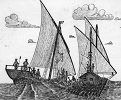 Aztlan and the trans-Pacific Los Balsas Expedition
In 1973, 12 men set sail from the South American country of Ecuador in three sailing rafts made of balsa logs, and arrived successfully, 178 days later, in Ballina, northern New South Wales. They followed Thor Heyerdahl's famous 1947 voyage of the Kon-Tiki raft from South America to the first islands of the Tuamotu Archipelago, about half-way across the Pacific. The Los Balsas Project aimed to prove rafts could sail further than Kon-Tiki, and the expedition aimed to prove that large numbers of people could have made trans-pacific journeys from South America to Australia.
Aztlan and the trans-Pacific Los Balsas Expedition
In 1973, 12 men set sail from the South American country of Ecuador in three sailing rafts made of balsa logs, and arrived successfully, 178 days later, in Ballina, northern New South Wales. They followed Thor Heyerdahl's famous 1947 voyage of the Kon-Tiki raft from South America to the first islands of the Tuamotu Archipelago, about half-way across the Pacific. The Los Balsas Project aimed to prove rafts could sail further than Kon-Tiki, and the expedition aimed to prove that large numbers of people could have made trans-pacific journeys from South America to Australia.
New Guinea Canoe Circa 1900, Teste Island - proa configuration (image right)
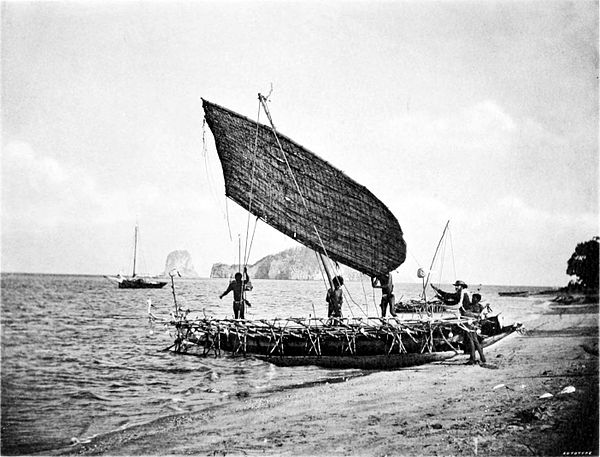 Illustrated Catalog of Indigenous Boats: Rafts and Reed ships; Pacific proa, pirogue, catamaran
Illustrated Catalog of Indigenous Boats: Rafts and Reed ships; Pacific proa, pirogue, catamaran
Tangaroa Pacific Voyage (Summer 2006) Testing Heyerdahl's Theories about Kon-Tiki 60 Years Later The Tangaroa raft sailed from Peru to the Polynesian islands (April to August 2006). Tangaroa finished a route between Raroia and Raiatea. The raft was then towed to Tahiti where it was shipped back to Norway. Tangaroa is not the only vessel that set sail following the illustrious example of Kon-Tiki in 1947. In fact, there have been at least 40 others (rafts, reed boats and canoes) according to Peter Capelotti who researched the topic in his book, "Sea Drift: Rafting Adventures in the Wake of Kon-Tiki".
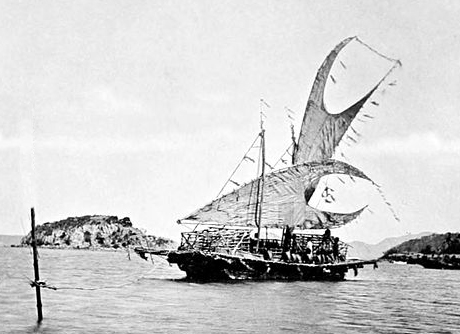 Canoes of Oceania
- Images and editorial associated with the topic collected by Harmen & associates. Lakatoi Canoe Elevala Island New Guinea (image right).
Canoes of Oceania
- Images and editorial associated with the topic collected by Harmen & associates. Lakatoi Canoe Elevala Island New Guinea (image right).

